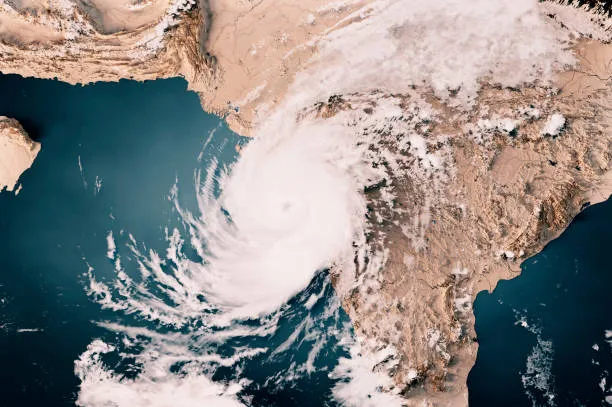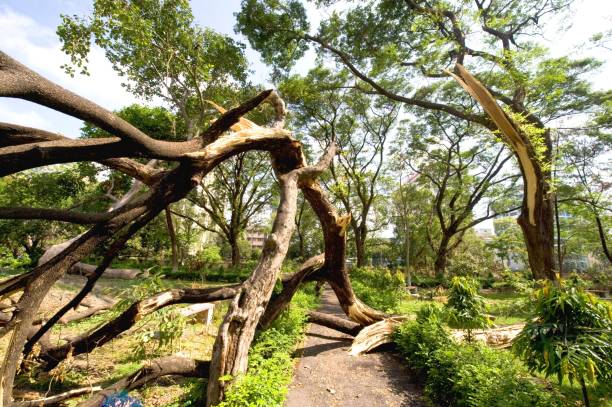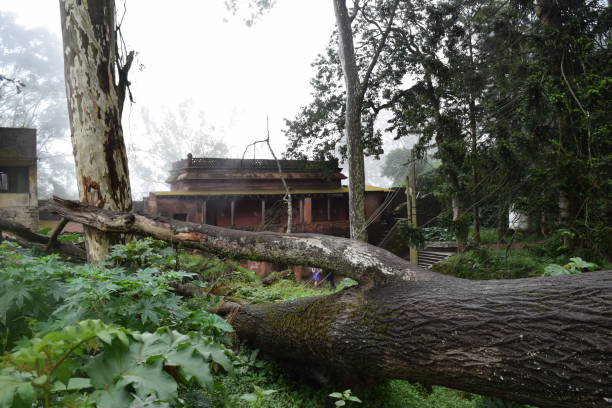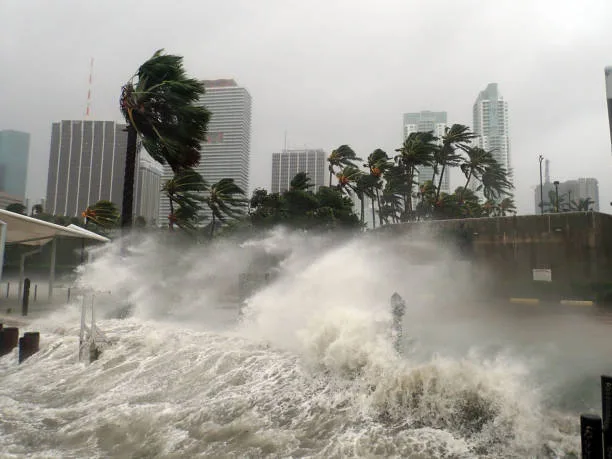Biparjoy Cyclone | 2023
Biperjoy – Tropical cyclones developed in 2023 in seven significant bodies of water, also referred to as tropical cyclone basins. When tropical cyclones reach maximum sustained winds of 35 knots (65 km/h; 40 mph), they will be given names by various weather agencies. 39 systems have formed thus far, 18 of which have been given names. Typhoon Mawar, which had a minimum pressure of 905 hPa (26.72 inHg), has been the storm with the highest intensity so far this year.
Cyclone Freddy, which killed over 1,400 people in Malawi, Mozambique, Madagascar, Zimbabwe, and Mauritius this year, is currently the deadliest tropical cyclone, while Cyclone Gabrielle, which damaged New Zealand to the tune of at least US$8.4 billion (NZ$13.5 billion), is the most expensive.

Very Strong Biparjoy Cyclonic Storm
A strong tropical storm named Biparjoy developed over the eastern Arabian Sea and made landfall close to the Pakistan-India border. Biparjoy, the second cyclonic storm and third depression of the 2023 North Indian Ocean cyclone season, developed from a depression that the India Meteorological Department (IMD) initially identified on June 6. Deep flaring convection caused the cyclone to gradually lose strength.
Biparjoy strengthened to a Category 3-equivalent tropical cyclone and a very dangerous cyclonic storm as it moved faster northeast.
The India Meteorological Department (IMD) started keeping an eye on the possibility of cyclonic circulation in the Arabian Sea on June 1.
On June 5, a cyclonic circulation developed over the Arabian Sea.
On the same day, cyclonic circulation led to the formation of a low-pressure area. The next day, it significantly worsened into a depression .

The system received a Tropical Cyclone Formation Alert from the Joint Typhoon Warning Centre (JTWC).
The depression was upgraded by the IMD to a deep depression and then to a cyclonic storm.[ Biparjoy was given to it. After that, the JTWC issued advisories regarding the system and designated it as Tropical Cyclone 02A.
Biparjoy steadily grew stronger, achieving Category 1-equivalent winds of 130 km/h (80 mph) hours later when its convection developed into a central dense overcast (CDO) with a developing eye.
The IMD upgraded the system to a severe cyclonic storm with winds of 100 km/h (65 mph) by 00:00 UTC on June 7. As the convective burst faded and the tops of the Biparjoy clouds warmed, the storm was pushed back towards its system core by an upper-level outflow. At 06:00 UTC, Biparjoy was upgraded to a very severe cyclonic storm, and as a result, the system’s Saffir-Simpson hurricane wind scale (SSHWS) classification was changed to Category 2.
The deep convection was pushed from the LLCC, and the cyclone was sheared as a result of moderate easterly vertical wind shear.
Deep flaring convection caused the cyclone to gradually lose strength.[
On June 11, Biparjoy surprisingly quickly developed and reached cyclone status comparable to Category 3.

Biparjoy peaked as a very strong cyclonic storm with maximum sustained winds of 165 km/h (105 mph) for three minutes. Convective organisation and areal extent increased as shear decreased. Along the southern edge, banding features are becoming more and more noticeable in satellite pictures. Over the northern semicircle, biparjoy gradually weakened due to convective banding.[As convection became asymmetric, the cyclone’s structure rapidly degraded.[On June 16, Biparjoy made landfall close to Naliya, India, with sustained winds of 60 mph, or 95 km/h.
Pakistan
Authorities and stakeholders, in particular the Provincial Disaster Management Authority (PDMA), have made proactive preparations to mitigate the potential effects of Cyclone Biparjoy. Plans for coordination and readiness have been developed through meetings with stakeholders. The PDMA has given the appropriate authorities the responsibility of identifying high-risk regions, starting public awareness campaigns, developing evacuation plans, and facilitating the secure evacuation of inhabitants from exposed coastal areas

.Authorities urged a voluntary evacuation of Karachi’s coastal residential neighbourhoods and took down billboards and signboards across the city.
The south-eastern coast was evacuated of a total of 81,000 people, and authorities have set up 75 relief camps at schools to offer aid.[ For the districts of Karachi, Hyderabad, Badin, Tando Allahyar, and Hyderabad, the weather office forecasted heavy rainfall and strong winds.
Thatta, Badin, Sajawal, Tharparkar, Karachi, Mirpurkhas, Umerkot, Hyderabad, Tando Allah Yar Khan, and Tando Mohammad Khan districts are among the regions that could be impacted. Approximately 9,000 houses, or about 55,000 individuals, are thought to be directly at risk. Most Sindhi districts may experience widespread wind-dust, thunderstorm activity, and heavy rains.
India

On June 12, 2023, Gujarat’s local government received alerts from India’s meteorological department advising them to be ready for possible evacuations. As the cyclone approached the land, locals in coastal areas were warned to stay inside. The state and federal disaster response teams were sent to the susceptible districts by the Gujarat government. In addition to Gujarat, it was predicted that the storm will bring rain to a number of other states along India’s western and southern shores. According to the Indian Meteorological Department (IMD), Goa, Karnataka, and some other areas of Maharashtra will get significant rainfall.
In total, 94,000 people have been successfully evacuated from coastal areas, according to Gujarati officials. The weather service issued alerts about possible flooding and blackouts in the area. Train operations were stopped.
Heavy rains and strong winds struck Gujarat’s coastal regions, killing three people in the districts of Kutch and Rajkot. The severe weather caused trees to be uprooted and a wall to collapse. Strong waves in Kutch also swept away tents that were located on Mandvi beach. The Dwarka area experienced strong tides as the hurricane neared the coast. Heavy rains and tall tidal surges were also experienced in the neighbouring state of Maharashtra. The bodies of four youths who had gone missing after swimming in the Arabian Sea close to Mumbai’s Juhu district were discovered. There were a total of 23 injuries, and 4,600 settlements experienced power disruptions.
The Meteorological Department has issued an alert due to the Biparjoy storm. Because of this, heavy rains and thunderstorms are also coming in many parts of the country.

Rajasthan has been devastated by a storm. whose significant impact was observed. A high alert has been issued by meteorology. According to the Meteorological Centre, the storm’s effects would be felt more in the state up until June 21. The storm is currently travelling steadily to the northeast. As a result of the impact of this system, Jalore Sirohi Barmer and Pali districts There have been reports of heavy to very heavy rains .As a result, some areas of the Jodhpur and Udaipur division reported significant rains. Due to the impact of this system, the districts of East and West Rajasthan could still experience heavy to very severe rainfall during the course of the next 24 hours.
Pali Sirohi, Rajsamand, and Udaipur The district has been placed on red alert. Within the next 24 hours, there is a chance of very heavy rain in these areas. More than 100 mm of rain had been recorded in certain locations. Ajmer, Jaipur, and Udaipur districts have all received an orange alert. Here, there’s a chance of very heavy rain. The storm’s effects will be felt throughout the entirety of Rajasthan on June 19. There will be less rain as the storm moves towards the Jodhpur division of western Rajasthan, and when heavy rains arrive, the storm’s effects can be visible in several districts of the Ajmer Jaipur Kota division of Rajasthan.
Cyclone Biparjoy is currently inflicting devastation in various regions of Rajasthan after wrecking havoc in Gujarat. Thunderstorms are occurring due to the Biparjoy storm, and on top of that, heavy rain is making people’s health problematic. Due to the damage caused by the Biparjoy storm, red alert, orange alert, and yellow alert have been issued in various districts of Rajasthan.
From June 17 to 20, “Bipperjoy Alert”
Significantly, Rajasthan will have heavy to very heavy rainfall from June 17 to 20 according to the Meteorological Department’s alert. Additionally, on June 16, roadways in several areas of Rajasthan became flooded as a result of the nonstop rain, and trees and power poles were uprooted in some locations due to the storm.
Flight-trains canceled from Biparjoy in Rajasthan, rain continues in many districts.
Low zone: Jaisalmer, Bikaner, and Churu
Along with other districts, Jaisalmer, Bikaner, Churu, Sikar, and Ajmer have been kept in the Yellow Zone. In Kota, there is a chance of strong winds and light rain. Low zone:

Southwest of Rajasthan
‘Biparjoy’, a cyclonic storm, has developed over Gujarat and the nearby Southwest Rajasthan over Southeast Pakistan. The remains of cyclonic storm “Biparjoy,” a deep depression, is currently over neighbouring Gujarat, southwest Rajasthan, and southeast Pakistan. It has been moving northeast at a speed of 17 kmph during the past six hours. At 11:30 IST today, it was roughly 70 kilometres southeast of Barmer and 160 kilometres southwest of Jodhpur, centred over southwest Rajasthan and bordering Gujarat.
Within the following six hours, it is quite likely to deteriorate into a depression and move east-northeastward. Following that, it is quite likely to continue in an east-northeast direction and keep a depression-like intensity until early on June 18.depression in the southwest of Rajasthan
Follow Our Digiknowledge.co.in Page for Latest update about Bikes, Cars, Sports, Government Policy and many more.




